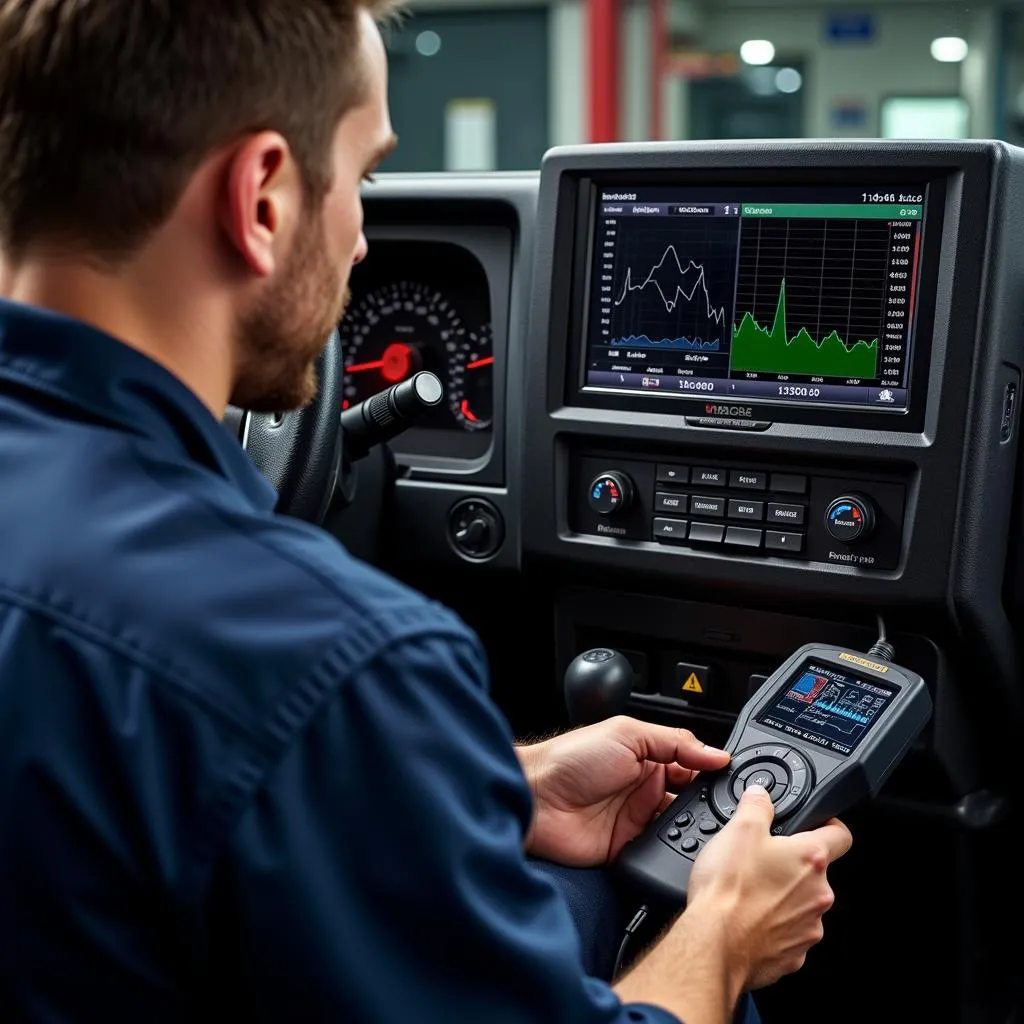Heavy duty scan tools are essential for diagnosing and repairing modern trucks. These sophisticated devices can access and interpret the complex electronic systems in today’s heavy-duty vehicles, providing crucial information about engine performance, emissions, transmission, brakes, and more. This comprehensive guide delves into the world of heavy-duty scan tools, equipping you with the knowledge to make informed decisions when choosing the right tool for your needs.
Why Invest in a Heavy Duty Scan Tool?
Unlike generic OBD2 scanners, heavy-duty scan tools are specifically designed to handle the intricate electronic systems of commercial trucks, buses, and other heavy vehicles. They offer a wider range of functions, including:
- Advanced Diagnostics: Heavy duty scan tools go beyond basic engine codes, providing in-depth diagnostics for various systems like ABS, transmission, and body control modules.
- Bi-Directional Controls: These tools allow you to interact with the vehicle’s systems, performing tests and actuations to pinpoint the root cause of issues.
- Fleet Management: Some heavy-duty scan tools offer fleet management features, enabling you to monitor the health and performance of multiple vehicles remotely.
- Time and Cost Savings: By providing accurate diagnoses and enabling efficient repairs, heavy-duty scan tools save you valuable time and money in the long run.
Key Features to Consider
Choosing the right heavy-duty scan tool can be overwhelming with so many options available. Consider these key features:
1. Vehicle Coverage: Ensure the scan tool supports the specific makes, models, and years of the trucks you work on.
2. System Coverage: Determine which vehicle systems the scan tool can diagnose, such as engine, transmission, ABS, SRS, and more.
3. Software Updates: Regular software updates are crucial to stay up-to-date with the latest vehicle models and diagnostic protocols.
4. User Interface: An intuitive and user-friendly interface enhances usability, making it easier to navigate menus and interpret data.
5. Data Logging and Reporting: Look for tools with data logging capabilities to track parameters over time and generate detailed reports for analysis.
6. Durability and Portability: A rugged and portable design is essential for withstanding the demands of a workshop environment.
Types of Heavy Duty Scan Tools
Heavy-duty scan tools come in various forms, each catering to different needs and budgets:
1. Handheld Scanners: These portable devices offer basic to advanced diagnostic capabilities and are suitable for on-the-go technicians.
2. Mobile Scanners: Combining the portability of handheld scanners with the power of PC-based software, mobile scanners provide comprehensive diagnostics and often connect wirelessly to tablets or smartphones.
3. PC-Based Scanners: These software-driven tools offer the most comprehensive diagnostic capabilities and typically require a dedicated laptop or computer.
Top Heavy Duty Scan Tool Brands
Several reputable brands dominate the heavy-duty scan tool market:
-
Launch: Known for their reliable and feature-rich scan tools offering extensive vehicle coverage and advanced functionalities.
-
TopScan: Renowned for their user-friendly interfaces, TopScan tools provide a wide range of diagnostic capabilities at competitive prices.
-
Autel: Autel offers a comprehensive selection of heavy-duty scan tools, from entry-level to professional-grade, known for their accuracy and durability.
Beyond Diagnostics: Additional Benefits
Heavy-duty scan tools offer benefits that extend beyond diagnostics, including:
-
Preventative Maintenance: Regular scans can identify potential issues before they escalate into major problems, minimizing downtime and costly repairs.
-
Improved Fuel Efficiency: By monitoring engine performance and identifying issues that affect fuel economy, these tools can help optimize fuel consumption.
-
Enhanced Safety: Diagnosing and addressing issues related to brakes, airbags, and other safety-critical systems ensures the vehicle operates safely.
Making the Right Choice
Selecting the right heavy-duty scan tool is crucial for efficient diagnostics and repairs. Consider these factors:
-
Budget: Determine your budget and explore tools that offer the best value for your money.
-
Experience Level: Choose a tool with a user interface and features that align with your technical expertise.
-
Specific Needs: Identify the specific diagnostic capabilities and features you require based on the types of trucks you service.
FAQs about Heavy Duty Scan Tools
1. Can I use a regular OBD2 scanner on a heavy-duty truck?
While some basic OBD2 scanners might read engine codes on heavy-duty trucks, they lack the comprehensive diagnostic capabilities and system coverage of dedicated heavy-duty scan tools.
2. How often should I update my heavy-duty scan tool software?
Regular software updates, ideally every few months, are crucial to ensure compatibility with the latest vehicle models and diagnostic protocols.
3. Can heavy-duty scan tools be used for programming modules?
Some advanced heavy-duty scan tools offer module programming capabilities, but it’s essential to verify the specific tool’s features and compatibility.
Conclusion
Investing in a reliable and feature-rich heavy-duty scan tool is essential for any mechanic or fleet owner dealing with modern trucks. From advanced diagnostics and bi-directional controls to preventative maintenance and improved safety, these tools offer a multitude of benefits that far outweigh their cost. By understanding your specific needs, researching available options, and choosing a reputable brand, you can equip yourself with the ultimate tool for keeping your heavy-duty vehicles running smoothly and efficiently. For more information on specific scan tool models and their capabilities, browse our selection of in-depth reviews and comparisons on DiagXcar.



